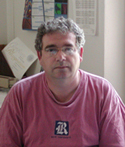Scholarly Interest Report
| |
|
| |
|
| B. Paul Padley | | Professor | | Professor of Physics and Astronomy | | | | e-mail:padley@rice.edu | | | - B.Sc. York University, 1981
- Ph.D. University of Toronto, 1987
| | | | Primary Department | | Department of Physics and Astronomy | |  | | | | Department Affiliations | | | Ken Kennedy Institute for Information Technology | | |
| Websites | | | Current Publication List
| | | Padley,T.W. Bonner Lab Hompage
| | |
| Research Areas | | | Experimental Elementary Particle Physics | | |
Experimental Particle Physics | | | Particle Physics is the science that tries to understand what the most elementary constituents of matter are and to deduce the laws of nature that govern their interactions. The Standard Model of particle physics provides an astonishingly good description of the fundamental particles and their interactions. The electroweak sector is beautifully and precisely calculable from photon exchange in QED with the addition of the gauge bosons W and Z to mediate the weak interaction. The strong interaction sector is described remarkably well at high energies by QCD. Many physicists, however, believe that the Standard Model must be incomplete since so many parameters, including the quark and lepton masses, the quark mixing angles, and the nature of the Higgs sector, are not calculable but instead must be inserted by hand. In addition recent results from astrophysics indicate that 95% of the content of the universe has not been identified.
Physics beyond the Standard Model, such as supersymmetry, grand unification, and superstrings, promises to enable calculation of many of these parameters from fundamental principles. New phenomena predicted in the mass range to be made accessible at the LHC includes a complete elucidation of the Higgs sector and the likely discovery of many new particles - the super-partners of the Standard Model quarks, leptons, and gauge bosons. These potential discoveries, and more probably those yet to be imagined, will most likely occur at a hadron collider with a detector that emphasizes high quality lepton detection. Such a detector is the one designed for use at the LHC: the Compact Muon Solenoid (CMS) detector.
| | |
| Selected Publications | | | Refereed articles | | | Natural Supersymmetry, Muon g−2, and the Last Crevices for the Top Squark
B. Paul Padley (Rice U.), Kuver Sinha (Syracuse U.), Kechen Wang (Peking U., CHEP & Beijing, Inst. High Energy Phys.). May 21, 2015. 14 pp.
Published in Phys.Rev. D92 (2015) 5, 055025
DOI: 10.1103/PhysRevD.92.055025
e-Print: arXiv:1505.05877 [hep-ph] | PDF | | | | | Measurement of the B(s) to mu+ mu- branching fraction and search for B0 to mu+ mu- with the CMS Experiment
CMS Collaboration (Serguei Chatrchyan (Yerevan Phys. Inst.) et al.). Jul 18, 2013. 17 pp.
Published in Phys.Rev.Lett. 111 (2013) 101804
CMS-BPH-13-004, CERN-PH-EP-2013-129
DOI: 10.1103/PhysRevLett.111.101804
http://arxiv.org/pdf/1307.5025.pdf | | | | | Observation of a new boson with mass near 125 GeV in pp collisions at s√ = 7 and 8 TeV
CMS Collaboration (Serguei Chatrchyan (Yerevan Phys. Inst.) et al.). Mar 19, 2013. 117 pp.
Published in JHEP 1306 (2013) 081
CMS-HIG-12-036, CERN-PH-EP-2013-035
DOI: 10.1007/JHEP06(2013)081
http://arxiv.org/pdf/1303.4571.pdf | | | | | | | | | | Observation of a new boson at a mass of 125 GeV with the CMS experiment at the LHC.
CMS Collaboration (Serguei Chatrchyan (Yerevan Phys. Inst.) et al.). Jul 2012.
Published in Phys.Lett. B716 (2012) 30-61
CMS-HIG-12-028, CERN-PH-EP-2012-220
DOI: 10.1016/j.physletb.2012.08.021 | | | | | Radiation Testing of Electronics for the CMS Endcap Muon System.
B. Bylsma, D. Cady, A. Celik, L.S. Durkin, J. Gilmore, J. Haley, V. Khotilovich, S. Lakdawala, J. Liu, M. Matveev et al.. Aug 2012.
Published in Nucl.Instrum.Meth. A698 (2013) 242-248
DOI: 10.1016/j.nima.2012.09.017 | | | | | Remote access to Xilinx programmable devices in the CSC endcap muon electronic system at CMS.
J. Liu, M. Matveev, P. Padley (Rice U.). 2011. 7 pp.
Published in JINST 6 (2011) C11001
DOI: 10.1088/1748-0221/6/11/C11001 | | |
|

